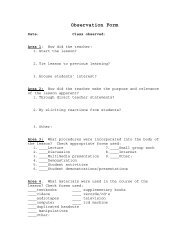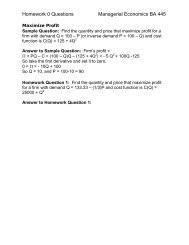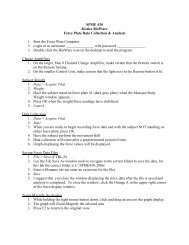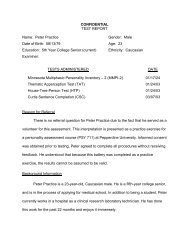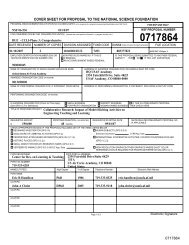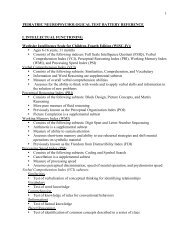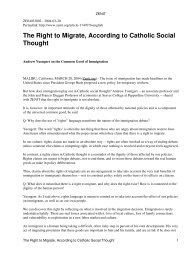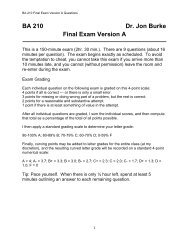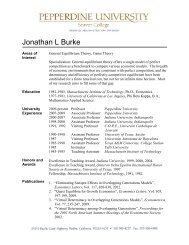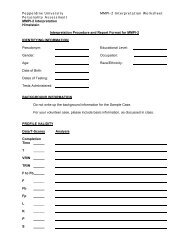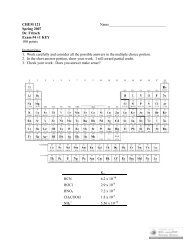Determination of the Configuration Equilibrium of a Four Coordinate ...
Determination of the Configuration Equilibrium of a Four Coordinate ...
Determination of the Configuration Equilibrium of a Four Coordinate ...
Create successful ePaper yourself
Turn your PDF publications into a flip-book with our unique Google optimized e-Paper software.
Lab #2 Nickel Salicylalimine Magnetism - 2have different colors and hence different visible absorption spectra. You will record <strong>the</strong>electronic absorption spectrum in several solvents to determine which bands correspond to eachgeometry.Two complexes are to be syn<strong>the</strong>sized. The first, bissalicylaldehydenickel(II)dihydrate, 2, is typical <strong>of</strong> octahedralnickel with six oxygens in <strong>the</strong> first coordination sphere, beinggreen and paramagnetic. This complex will be used as startingmaterial in <strong>the</strong> syn<strong>the</strong>sis <strong>of</strong> <strong>the</strong> more interesting compound bis-(N-isopropylsalicylaldimine) nickel(II), Ni( i PrSal) 2 , 1. The syn<strong>the</strong>sis <strong>of</strong> 1 is an example <strong>of</strong> aSchiff base condensation reaction that is <strong>of</strong>ten used, with a metal ion as a template (Ni 2+ in thiscase) to prepare.The bis-(N-isopropylsalicylaldimine)nickel(II) is soluble in organic solvents and isunusual because it exists as an equilibrium mixture <strong>of</strong> a square-planar, diamagnetic form and atetrahedral, paramagnetic form. This equilibrium has been studied by magnetic andspectroscopic methods 1-4 and by nuclear magnetic resonance (NMR). 5 References to many o<strong>the</strong>rstudies <strong>of</strong> this and similar Schiff-base complexes may be found in <strong>the</strong> literature cited. The NMRstudy is particularly interesting in that <strong>the</strong> complex contains two asymmetric carbons (one oneach chelate ring) and <strong>the</strong> NMR spectrum shows distinct peaks for <strong>the</strong> meso and dd-11 forms.The N-isopropyl complex to be syn<strong>the</strong>sized is tetrahedral and fully paramagnetic in <strong>the</strong>crystalline state with eff = 3.28 B.M. In solution in inert solvents (benzene, chlor<strong>of</strong>orm, etc.) <strong>the</strong>moment is considerably less since <strong>the</strong>re is some planar form in equilibrium with <strong>the</strong> tetrahedralform.Preparation <strong>of</strong> Bis-salicylaldehyde)Ni(II)•2H 2 O, 2. Dissolve 5 g (0.0408 moles) <strong>of</strong>salicylaldehyde in 10 ml <strong>of</strong> 50/50 water/ethanol mixture and heat to boiling. To this add a hotsolution <strong>of</strong> 5.01 g (0.0205 moles) <strong>of</strong> nickel acetate tetrahydrate, Ni(C 2 H 3 0 2 ) 2 •4H 2 0 (FW = 248.9g/mol) dissolved in 10 mL water with stirring. Allow <strong>the</strong> solution to cool, filter in a Buchnerfunnel and wash successively with warm water, ethanol, and diethyl e<strong>the</strong>r. Allow product to airdry. Weigh and compute yield.Preparation <strong>of</strong> Bis-(N-isopropyllsalicylaldimine)Ni(II), 1. Place your entire yield <strong>of</strong> <strong>the</strong>complex 2 in a round bottom flask and add 25 ml <strong>of</strong> ethanol and a 10% mole excess over 2 moles(CH 3 ) 2 CHNH 2 for one mole Ni(II) and reflux. After <strong>the</strong> reaction is complete, cool and filter <strong>the</strong>
Lab #2 Nickel Salicylalimine Magnetism - 3product. Wash with ethanol, weigh <strong>the</strong> product, and take a melting point. Compare to <strong>the</strong>literature reported melting point in reference 4 .<strong>Determination</strong> <strong>of</strong> <strong>the</strong> Solid State Magnetic Moment. A Gouy balance will be used todetermine <strong>the</strong> solid state magnetic moment <strong>of</strong> compound 1. The following equations will allow acalculation <strong>of</strong> <strong>the</strong> effective magnetic moment, eff . The corrected molar susceptibility, X corr m , isX corr m = X m - X d , where X m is <strong>the</strong> molar magnetic susceptibility and X d is <strong>the</strong> molar diamagneticcontribution which results from all <strong>of</strong> <strong>the</strong> paired electrons in <strong>the</strong> molecule. X d is a negativenumber and is determined from Pascal's constants. 5 For Ni( i Pr-Sal) 2 , X d = -220 x 10 -6 cgs/mole.The effective magnetic moment, eff is eff = 2.84 (X corr m T) 1/2 (3)<strong>Determination</strong> <strong>of</strong> <strong>the</strong> Solution Magnetic Moment. Often <strong>the</strong> Gouy method is used; however,ano<strong>the</strong>r method involves using nuclear magnetic resonance (NMR) spectroscopy. The keyequation for determining X g is due to D. F. Evans 6 and is for <strong>the</strong> 200 MHz NMR spectrometeryou will use:where is <strong>the</strong> chemical shift separation in Hz (see below), is <strong>the</strong> spectrometer frequency (200x 10 6 Hz), c is <strong>the</strong> concentration in grams/mL, and X 0 g is <strong>the</strong> gram susceptibility <strong>of</strong> <strong>the</strong> puresolvent. Make up a solution by dissolving 0.20 to 0.25 g <strong>of</strong> Ni( i PrSal 2 ) in CHC1 3 (not CDC1 3 !Why?) and dilute to <strong>the</strong> mark in a 10.0 mL volumetric flask. Transfer enough <strong>of</strong> <strong>the</strong> solutioninto a clean NMR tube to give ca. 2 cm column <strong>of</strong> solution. Carefully insert <strong>the</strong> inner concentricNMR tube which contains enough pure CHC1 3 to completely fill <strong>the</strong> narrow portion (see Figure1). Submit your NMR tube for analysis. An NMR spectrum <strong>of</strong> your sample focused on <strong>the</strong>CHC1 3 resonances, i.e., <strong>the</strong> inner and outer solvent peaks (Figure 2) will be returned to you.Measure <strong>the</strong> separation between <strong>the</strong> two peaks. Solve equation 4 for X g . X 0 g for CHC1 3 is -0.497x 10 -6 cgs/gram. Now calculate X corr m and eff as before.
Lab #2 Nickel Salicylalimine Magnetism - 4Figure 1.Figure 2. 300 MHz NMR<strong>Determination</strong> <strong>of</strong> <strong>the</strong> UV-vis Absorbance Spectra. The UV-vis absorbance instrument in KSC440 will be used to collect <strong>the</strong> absorbance <strong>of</strong> compound 1. Before you begin, please carefullyread <strong>the</strong> instructions above <strong>the</strong> instrument so that you will know how to operate <strong>the</strong> spectrometerand save your data properly. Record <strong>the</strong> absorbance spectrum in <strong>the</strong> range 300 - 800 nm.Record <strong>the</strong> spectrum using CHC1 3 and toluene solvents. Determine <strong>the</strong> correct concentration tokeep <strong>the</strong> peaks on scale. Which <strong>of</strong> <strong>the</strong>se solvents is more polar? Can you identify peaks due to<strong>the</strong> planar and tetrahedral isomers? Note <strong>the</strong> color <strong>of</strong> <strong>the</strong> solid tetrahedral isomer. This shouldgive you a clue as to <strong>the</strong> peak assignments in solution. Assign <strong>the</strong> peaks for <strong>the</strong> tetrahedral andplanar isomers; identify <strong>the</strong> electron transitions involved for each form.In your report answer <strong>the</strong> following questions:A. Using simple crystal field <strong>the</strong>ory, show why <strong>the</strong> tetrahedral complex has two unpairedelectrons while <strong>the</strong> planar isomer is diamagnetic.B. Ni( i PrSal) 2 is called a Schiffs base complex. Why?C. What o<strong>the</strong>r experiments can you think <strong>of</strong> which can verify that nickel is really undergoing ageometry change in this complex?D. Can you suggest an alternate explanation (i.e., o<strong>the</strong>r than a planar tetrahedral equilibrium) for<strong>the</strong> magnetic results in this.
Lab #2 Nickel Salicylalimine Magnetism - 5References1. Holm, R. H., Journal <strong>of</strong> <strong>the</strong> American Chemical Society 1961, 83, 4683-90.2. Holm, R. H.; Chakravorty, A.; Dudek, G. O., Journal <strong>of</strong> <strong>the</strong> American Chemical Society1964, 86, (3), 379-87.3. Holm, R. H.; Swaminathan, K., Inorg. Chem. 1963, 2, 181-6.4. Sacconi, L.; Paoletti, P.; Ciampolini, M., Journal <strong>of</strong> <strong>the</strong> American Chemical Society1963, 85, 411-16.5. Pignolet, L. H.; Horrocks, W. D., Jr.; Holm, R. H., Journal <strong>of</strong> <strong>the</strong> American ChemicalSociety 1970, 92, (7), 1855-63.6. Evans, D. F., Journal <strong>of</strong> <strong>the</strong> Chemical Society 1959, 2003-5.Adapted with permission from Dr. Kent Mann, University <strong>of</strong> Minnesota.
Lab #2 Nickel Salicylalimine Magnetism - 6Pre-Lab Questions1. Using <strong>the</strong> Ligand Field or MO <strong>the</strong>ory <strong>of</strong> bonding, predict <strong>the</strong> number <strong>of</strong> unpaired electronsfor Ni(II) complexes <strong>of</strong> tetrahedral, square planar, and octahedral geometry.2. What is a Schiff base condensation reaction?3. What is a spin-only magnetic moment? Why is that moment used for Ni(II) in this case?4. Why do you change solvents between preparation <strong>of</strong> <strong>the</strong> bis-(salicylaldehyde)Ni(II) • 2H 2 Oand <strong>the</strong> bis-(N-isopropylsalicyladimine)Ni(II)?




